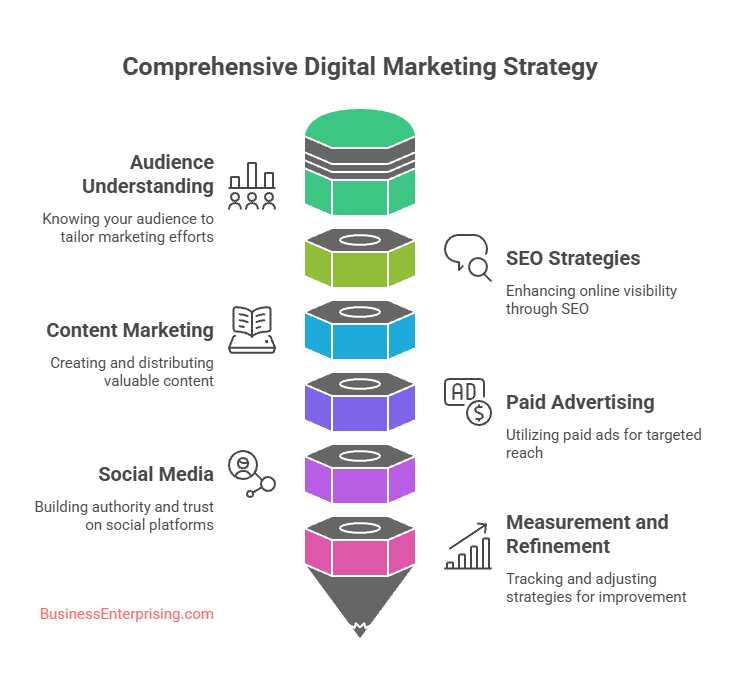
Many businesses waste time by chasing trends instead of building systems. Therefore, it helps to take a step back and think long term. When you start with strategy, your campaigns stay focused and easier to manage. Additionally, your message becomes more consistent across platforms.
You don’t need to master every tool at once. Instead, focus on what works for your audience and fits your goals. For some, that means stronger SEO. For others, it means better email or targeted ads. Each option has a place, but timing matters.
Digital campaigns work better when each part supports the next. Your blog can feed social content. Your ads can drive traffic to your offers. Additionally, email can support sales without pushing too hard. That kind of planning reduces friction and helps people move through your funnel more naturally.
However, even the best plan needs regular updates. You should track what works, cut what doesn’t, and adjust as you grow. That process keeps your strategy aligned with your results. Additionally, it helps your team stay clear on what matters most. Start small. Build a clear message, pick your platforms, and measure what counts. When you stay consistent, your results will grow without needing to start over every time.
Understanding Your Audience Before You Market
Marketing works better when you know who you’re talking to. You can waste a lot of time without that understanding. Many businesses skip this step, then wonder why their results feel flat. Before you choose your tools, you need to know your audience. Start by outlining buyer personas based on your actual customers. These are profiles that describe common traits, needs, and habits. Additionally, you can include their goals, pain points, and how they make decisions. These insights help you shape your message so it actually connects.
Behavioral data also matters. Look at what your audience does across your website, email, or social platforms. For example, you might track which blog posts get the most views or which emails get clicks. That data tells you what topics interest them. Therefore, you can spend more time creating content that matters to them.
Segmentation lets you group your audience based on shared traits. You can then send more targeted messages to each group. For example, one segment may prefer short videos while another responds to detailed guides. Additionally, you can adjust tone or timing based on what works best for each group.
Digital marketing strategies only work when they reach the right people in the right way. You can’t guess your way through this process. Therefore, take time to learn who you’re serving. When your message aligns with their needs, you waste less and get better results.
SEO Strategies That Drive Long-Term Visibility
SEO takes time, but it keeps working long after the campaign ends. You don’t need tricks or shortcuts. Instead, focus on what helps users.
Start with on-page SEO. That includes page titles, headers, image text, and how you write your content. Additionally, you should use keywords that match what your audience actually searches for. That means thinking about their intent, not just the words they type.
Content structure matters too. Break up long text with headings and short paragraphs. Use lists, spacing, and simple formatting to guide the reader. Therefore, your content becomes easier to scan and faster to understand.
Technical SEO is less visible but still important. Your website needs fast loading times and clean URLs. Additionally, mobile responsiveness and a secure connection help search engines trust your site. You don’t need advanced coding skills to fix many of these basics.
Keyword research is about more than picking popular phrases. You want to match your content to the problems your audience needs solved. That connection helps people stay longer and interact more with your site. Over time, search engines reward that kind of engagement.
Digital marketing strategies should always include long-term SEO planning. Without it, you rely too heavily on paid ads or short bursts of attention. Therefore, give your content the structure, focus, and support it needs to rank well over time. SEO may feel slow, but it builds steady results. Stay consistent, update what’s old, and write for the reader. When your site works well and answers real questions, search traffic usually follows.
Content Marketing Across Multiple Formats
Content marketing works best when it shows up in more than one place. You can reach more people without starting from scratch. Many businesses create once and repurpose that content across different formats.
Start with a clear plan. Think about what your audience wants to learn and how they prefer to consume it. Some people read blogs, others watch videos, and many scroll through social feeds. Therefore, you should give your content multiple entry points.
Blogs are a strong base. You can write in-depth posts and later turn them into shorter pieces. For example, one blog can become a podcast topic, a video outline, or a social caption. Additionally, clips from podcasts and videos can be shared as short posts or reels.
Each format helps you speak to a different part of your audience. Videos help explain things quickly. Podcasts offer a more casual tone. Social content keeps your brand visible. Therefore, using multiple formats creates more touchpoints and builds trust over time.
Repurposing content saves time and keeps your message consistent. You don’t need new ideas every day. Instead, you work smarter by reshaping what you already made. Additionally, this method supports stronger branding and better reach.
Digital marketing strategies depend on visibility and frequency. Content that appears in several places has more chances to get seen. That matters when attention spans are short and platforms change fast. Keep your process simple. Plan once, create once, and then adapt across channels. That way, your content keeps working without doubling your effort.
Paid Advertising: When and How to Use It
Paid advertising works best when paired with clear goals. You should use it to drive traffic, collect leads, or boost visibility. However, knowing when to spend is as important as knowing how.
Pay-per-click ads help you reach people searching for something specific. You only pay when someone clicks, so every dollar counts. Therefore, PPC works well when you target high-intent keywords with clear offers. Additionally, Google Ads provides data you can use to adjust campaigns quickly.
Display ads show up across websites and apps. These build awareness more than immediate action. They work best when paired with remarketing. For example, someone visits your site and later sees your ad elsewhere. That repeat exposure can improve conversion rates over time.
Social ads work well for brand discovery and engagement. Platforms like Meta and Instagram let you target by interest, behavior, or demographics. You can test different formats, such as image posts, stories, or video reels. Additionally, many platforms offer tools to track performance by the hour or day.
You should always measure return on investment. Track cost per click, cost per lead, and cost per sale. Therefore, you can shift budgets toward what works and reduce waste. Simple dashboards or ad manager reports help you stay informed.
Digital marketing strategies often include paid ads to fill gaps or speed up results. You don’t need to run large campaigns. Start small and review often. When you see consistent performance, you can scale with more confidence and better outcomes.
Social Media That Builds Authority and Trust
Social media helps you stay visible and credible if you use it with intention. You don’t need to be everywhere at once. Instead, focus on the platforms your audience already uses. Therefore, pick one or two that align with your content style and goals.
Each platform has its strengths. LinkedIn works well for professional topics. Instagram supports visual content. Additionally, Facebook and TikTok offer wide reach for video and community-based posts. You should post where your message fits the format and feels natural.
Voice matters more than volume. Your tone should reflect your brand’s personality and values. Therefore, use the same style across platforms so your posts feel consistent. That familiarity helps people trust what you share.
Storytelling builds stronger connections than product promotion alone. Share real experiences, lessons learned, or behind-the-scenes moments. Additionally, use short captions or videos that show how you help others succeed. When you focus on value, people stay engaged.
You don’t need to post every day. What matters is posting with purpose. Plan a few types of content that speak to different stages of your audience’s decision process. Therefore, you create a mix of useful, relatable, and persuasive posts.
Digital marketing strategies that include social media work better when they feel honest. Trust grows over time through steady effort and clear communication. Be consistent, reply to comments, and keep your focus on helping your audience.
Authority comes from being present and useful, not from pushing for attention. That kind of presence leads to stronger results and better business over time.
Measuring and Refining Your Strategy
You can’t improve what you don’t measure. Every marketing effort should tie back to a clear set of performance goals. Therefore, tracking results is not optional if you want consistent progress.
Start by defining which metrics matter for each campaign. Website traffic, click-through rates, and conversion rates all tell a different part of the story. Additionally, time on page, bounce rate, and cost per lead help explain what your audience values. You don’t need to track everything, but you should track enough to spot trends.
Use reporting tools that match your platforms. Google Analytics gives you insight into website behavior. Meta’s ad manager shows how paid social campaigns perform. Additionally, email platforms often show open rates, clicks, and unsubscribes. These tools work best when checked regularly, not once a quarter.
Raw numbers only help when you connect them to outcomes. Look for patterns and ask why results changed. For example, a lower bounce rate may mean your content fits the audience better. Therefore, repeating what worked could lead to better outcomes.
Digital marketing strategies depend on your ability to adapt. Campaigns that once worked may lose steam over time. You can’t expect one plan to keep working forever. Instead, use performance data to make small changes often.
Additionally, keep your goals tied to business needs. If your goal is sales, focus on metrics that show buying intent. If it’s awareness, track reach and engagement. That clarity keeps your team aligned and focused.
You don’t need perfect data. What matters is consistent review and small corrections. Over time, those updates make your strategy stronger.
Conclusion
Marketing works best when every part of your plan supports a larger goal. That kind of alignment helps you stay focused and clear. Therefore, each tactic should tie back to what your business needs to grow.
You don’t need to do everything at once. Instead, pick the methods that match your strengths, audience, and budget. Additionally, stay flexible so you can adjust when results change. The best strategies evolve based on feedback and data.
Digital marketing strategies work long term when you build on what already performs. That means testing often, cutting waste, and improving what you keep. You don’t need perfect outcomes to see progress. What matters is being consistent and responsive.
Start with your audience. Then build content that fits their habits. Choose your channels based on how they prefer to connect. Additionally, use reporting tools to measure your progress and correct as needed. Small changes made often can lead to strong results over time.
Marketing doesn’t have to feel complex. When each part of your system works together, it becomes easier to manage and scale. Therefore, take your time and focus on steady growth. Keep your message simple, your process clear, and your goals realistic. That approach helps you use your time well and reach more of the right people.



